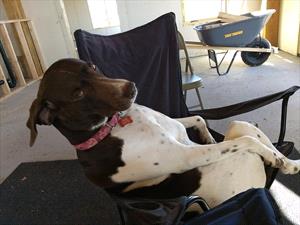dog sitting in travel chair

Photo by Sharon Shriver
Many heart diseases, when severe enough, result in congestive heart failure. When the left side of the heart is diseased, this presents as a build-up of fluid in the lungs, causing breathing difficulties and shortness of breath which can be severe. However, before such signs occur, many animals start to have an increase in their breathing rate. This can be subtle and is best detected when your pet is sleeping (because there are not a lot of things that affect your pet’s breathing rate when they’re asleep).
Willow.jpg - Caption. [Optional]
![Willow.jpg - Caption. [Optional] Tan long coat Chihuahua laying on a gray couch](/AppUtil/Image/handler.ashx?imgid=7974141&w=150&h=259)
Willow is a 14-year-old Chihuahua with heart issues. Photo courtesy of Janet Stomberg
AdobeStock_123232683.jpg - Caption. [Optional]
![AdobeStock_123232683.jpg - Caption. [Optional] Gray cat sleeping on a wooden floor.](/AppUtil/Image/handler.ashx?imgid=7974174&w=&h=)
Your veterinarian can use your observational skills and record of your pet’s breathing to help manage your pet's heart disease in three ways:
1. Preclinical heart disease. Heart disease in dogs and cats that is destined to cause congestive heart failure progresses over time from mild disease to more severe disease. When it gets severe enough, fluid builds up in the lungs (congestive heart failure), requiring treatments to relieve this congestion. However, before it reaches that stage, your veterinarian might have you start measuring the sleeping respiratory rate (SRR) so that you catch congestive heart failure at the earliest stage possible. Usually, such measurements start when the disease is moderate-to-severe, but not yet showing signs of congestive heart failure. Your veterinarian will use tests such as chest X-rays (radiographs) or cardiac ultrasound (echocardiography) to determine when measuring the SRR is appropriate.
2. Diagnosis of congestive heart failure. Sometimes signs of congestive heart failure are subtle and easily confused with other non-cardiac diseases. In such cases, your veterinarian might get you to measure your pet’s sleeping respiratory rate (SRR) to help rule out a diagnosis of congestive heart failure – if the rate is normal, congestive heart failure is extremely unlikely and your veterinarian can focus on other causes of your pet’s clinical signs.
3. Management of congestive heart failure (pulmonary edema). If your veterinarian diagnoses your pet with congestive heart failure and institutes treatment for it (with diuretics and other drugs), they will probably get you to monitor the response to medications by measuring your pet’s sleeping respiratory rate (SRR) at home. Studies are finding that measuring the SRR is a very sensitive way to tell if your pet’s heart failure is being well controlled by drugs or not. When the drugs are working well, the pet should be feeling good, but more importantly, the SRR should be between 10-25 breaths per minute (in most cases, it will be less than 30 breaths per minute). If the SRR increases or exceeds 30 breaths per minute, it might indicate that there is fluid building back up in the lungs. Your veterinarian will generally recommend you return to the clinic to confirm this is the case, or they might instruct you to increase the dose of diuretics.
How to measure SRR
SRR and RRR (Resting respiratory rate) should be obtained when the pet is comfortable, in a comfortable environment (not too hot or cold), and not after any exertional activity. If sleeping, the pet should be in a “deep sleep”, not in a twitching or “dreaming” state.
The respiratory rate should be counted for a full minute if possible, although 30 seconds is often sufficient. One breath is made up of 2 components: breathing in (inspiration or inhalation) and breathing out (expiration or exhalation).
These videos show 2 dogs and a cat either sleeping or resting quietly. The counter records each breath for over a full minute. Watch these to understand how this is done.
Canine Sleeping Respiratory Rate
Feline Sleeping Respiratory Rate
Canine Resting Respiratory Rate
There’s an App for That!
Apple Store: Ceva’s Cardalis RR app
These allow you to measure the respiratory rate by tapping the screen of your smartphone or tablet in time with the breathing. Once you've got the results, you can email them to your veterinarian and talk about the next steps for your pet's care.